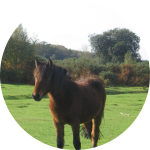| Home |
Welcome to the Horse Stall |
|
Horse Stall contains all types of information for Horse Lovers.
There are a number of products branded horse gifts and products.
Horse Articles :: Horse Breed Glossary - R
|
Horse Breed Glossary - R |
|
RUSSIAN DON HORSE An under saddle and harness horse, the Russian Don Horse, got it start in the Cossack Calvary. This was the most feared, but famous of cavalries and made up of tough and rugged horses. Originating in the Soviet Union by breeders close to the Volga and Don river, the horse was originally small. However, sometime in the 1800's, the Russian Don was bred with the breeds of Karabakh and Persian Arabs to create a more refined and much larger breed of horse. Extremely hardy horses, they have the ability to withstand harsh weather, little foods stores, and still survive. The Russian Don Horse has expressive eyes, larger nostrils than average, and occasionally a hooked nose, but generally straight. They carry straight shoulders, muscular chest, long backs, and clean legs. They generally stand from 15.1 hands to 16 hands. You can find the Russian Don Horse in various colors such as gray, bay, and chestnut. The Russian don horse carries a great deal of endurance and a mild, but even temperament. Used as both a saddle and harness horse, the Russian Don horse is quickly gaining popularity throughout the world. RUSSIAN HEAVY DRAFT In Russia, the people had a need for both heavy draft horses and small draft horses that were strong and fast as well as economical in terms of feeding and managing. The genetics of the small draft horse were from the native Ukrainian breeds, the mountain Ardennes, and from the Orlov Trotter and Brabancon breeds. In the 1860's, systematic breeding began. Most of the breeding was done at Peter's Academy, Chesma stud, Kochubei and Chaplits and the Derkulski stud. Because the Russian Heavy Draft horse was easy to feed (economically) and the horse itself was highly adaptable to the environment, they became very popular. THe horses are still bred in various areas of the world. While the horse has many strong muscles, they are not very large. Their trunk is long and they have well developed joints. They are about 152 cm tall at the withers and weigh between 550 and 700 kg. Russian Heavy Draft horses have short necks, wide foreheads, long back and a drooping croup. Their front legs seem to be set too far apart, and they are quite short. Most of the breed are chestnut, brown and a few are bay. They are known for their willing dispositions, fair speed and strength. Some farms use the mares for milk production, and they can yield 5540 kg of milk for periods of up to 25 years. They have good fertility and live long lives. RUSSIAN TROTTER When the Orlov Trotter breed was crossedw ith the American Standardbred (American trotter), the Russian Trotter breed was born. This crossbreeding occurred in the 1890's, but the formation of the breed was not complete until about 1950. When people wanted to improve the speed of the Russian trotter, breeders crossed them with Russian trotters- and this continues to be part of the breeding process. Modern Russian Trotters are harness horses. They are proportionately built with well developed muscles. They have light heads and a straight profile, long necks and a flat croup. Their appearance is not as stunning as the Orlov however, as the Russian Trotter often has defects like bowed legs or dropping croups. Most Russian Trotters are bay, black and chestnut, and a few are grey in color. They stand an average of 161 cm tall, and have record trot speeds. There are currently 12 lines that are associated with the Russian Trotter breed. SADDLEBRED HORSE The saddlebred was descended from the Narraganset Pacer, the breed that Paul Revere rode during his famous ride, and American Horses such as those Daniel Boone rode through Cumberland Gap into Kentucky. After the war of 1812, it was important for people in Kentucky to have good saddle horses. They were a large part of the development of settlement in the Ohio Valley. The first horse show, on record, was held in Lexington, Kentucky in 1817. By 1846, and the Mexican War, the American Saddlebred was an established breed of horse. They were great in war. They gained even more fame during the Civil War, when famous generals rode them- including stonewall Jackson, Lee, and Grant. Increasing popularity and the commercial value of Saddlebred horses caused the formation of the breed association and registry to occur in the 1880's. American Saddlebreds are excellent jumpers, carriage horses, and dressage- and actually can be trained to handle almost any task. About the Author |
Top Horses |
|
| Top Horse Movies | |
Horse Resources |
|
Horse Health |
|
Horse Breeds |
|
More Horses |
|


| Copyright 2005-2021 DR Management All rights reserved |
Dog Gifts | Wildlife Gifts | Handmade Horse Gifts |
